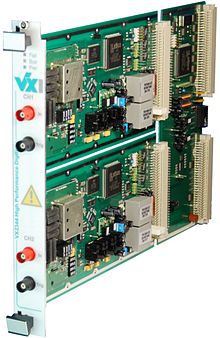VME extension for instrumentation
The V ME e X tension for I nstrumentation bus ( VXIbus ) is a common in industrial instrumentation bus . The VXIbus is an extension of the VME bus known in the industry , whereby the VME bus was originally developed specifically for use with the 68000 series of processors from Motorola . The VXIbus is used, for example, in the area of automatic test systems in electronics production.
history
In 1985, Hewlett-Packard , Tektronix , Wavetek, Racal-Dana and Colorado Data presented the VXIbus developed for the US military for the first time. Since 1987, cross-company standardization and further development has been promoted within the framework of the VXIbus Consortium and is defined in the IEEE standard 1155-1992 . The VXIbus Consortium includes the companies Agilent , Bustec , Tektronix, Wavetek, Fluke and National Instruments .
construction
In contrast to the VME bus, the VXI bus has dynamic addressing, manual address and interrupt allocation. This avoids malfunctions due to double addressing. In this context, a similar development was observed in the PC sector when switching from ISA to PCI bus, with the VXI bus being standardized before the PCI bus. The VXI bus has the following performance data, among others:
- a 32-bit address bus
- a data transfer rate of up to 16 MHz
- the possibility of addressing up to 256 devices on one bus
- a multi-master capability, so that several "master" devices can be operated simultaneously on one bus
Applications are in industrial test systems, whereby the VXI bus is also used to operate real-time applications.
The VXI bus competes with the GPIB bus, as so-called GPIB bus-capable "stand-alone" devices such as oscilloscopes , function generators , programmable power supplies or digital multimeters are increasingly being implemented in the form of VXI bus modules. In addition to extensions and improvements within the electrical signal variety, the range of available module sizes has also been expanded, whereby VME modules can also be operated in VXI mainframes using suitable adapters. The addition of the “Size C” and “Size D” modules makes it possible to accommodate complex measuring devices in one slot.
The most common size is "Size C". The module width for VXI devices has been increased to 1.2 inches , so that the use of shielded housings and internal shielding surfaces is made easier. This reduces the risk of electric shocks and the sensitive measurement technology is better protected from external interference in the shielded VXI housing.
Web links
- VXIbus Consortium , English
- VXIplug & play Alliance via the IVI Foundation , English
- VXIbus description , English
Individual evidence
- ↑ Journal elektronik industrie 7-2009, page 17
- ↑ IEEE Std 1155-1992 , (English) IEEE Standard for VMEbus Extensions for Instrumentation: VXIbus -Description
- ↑ VXI Bus Consortium, Member List (English)

